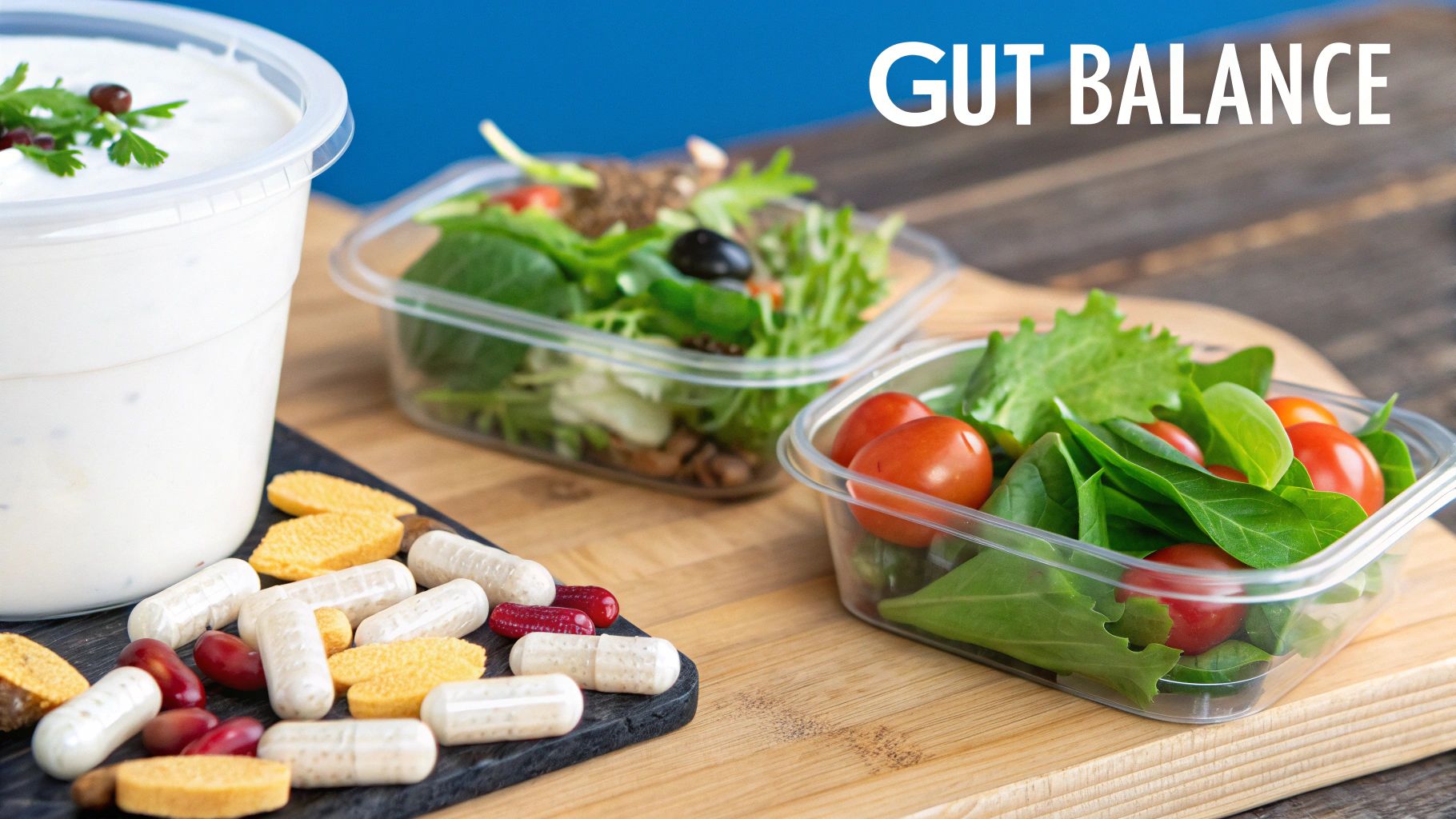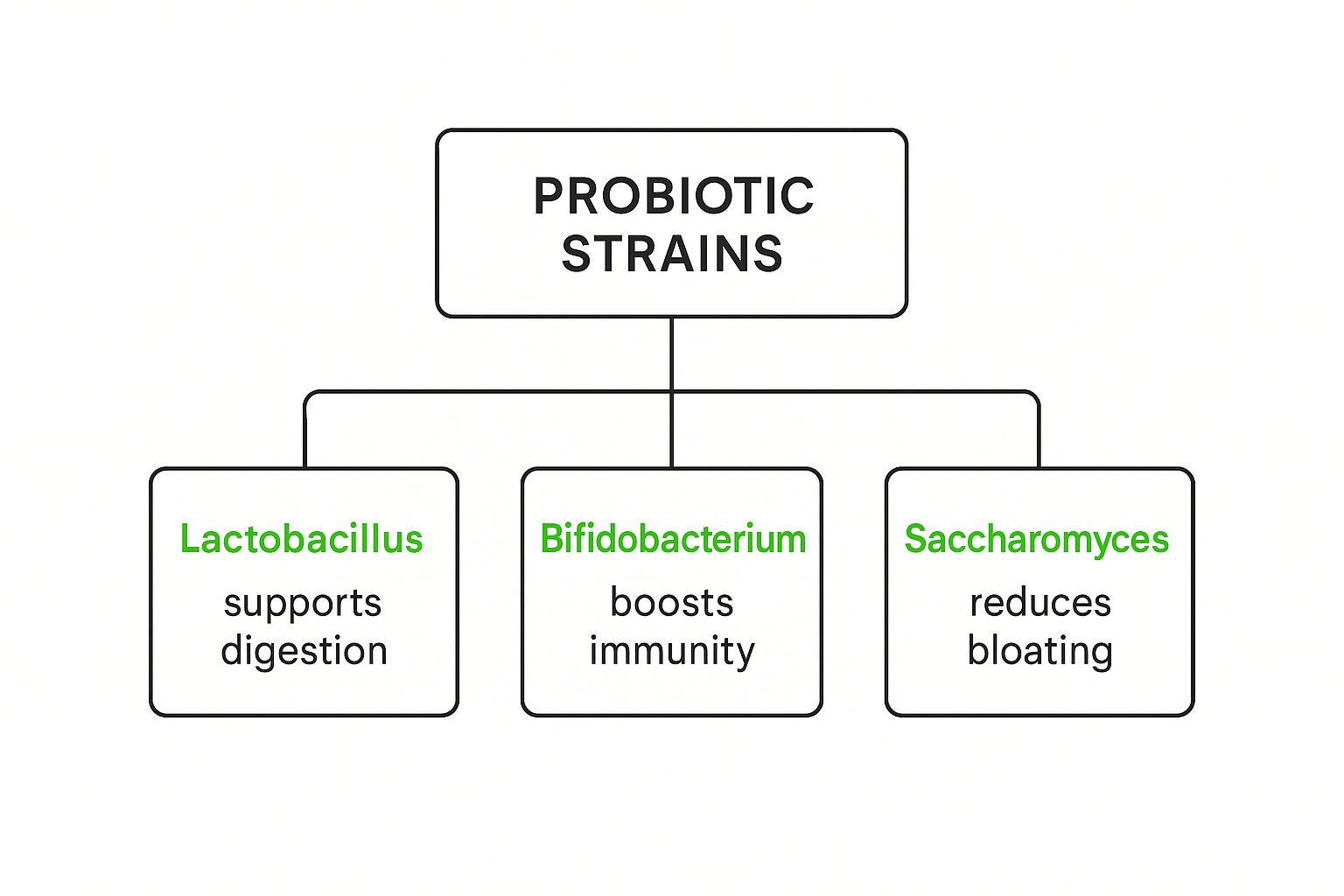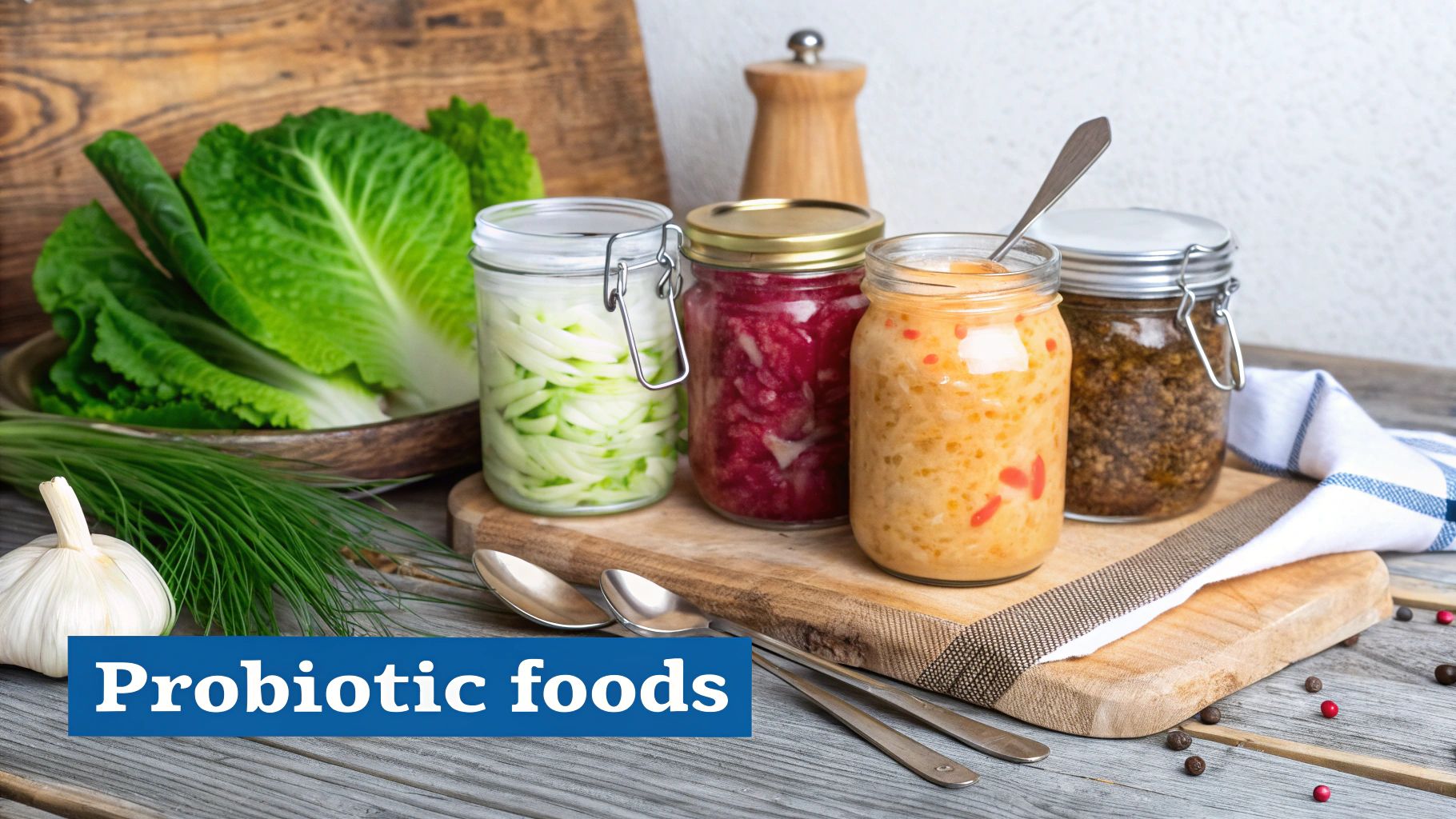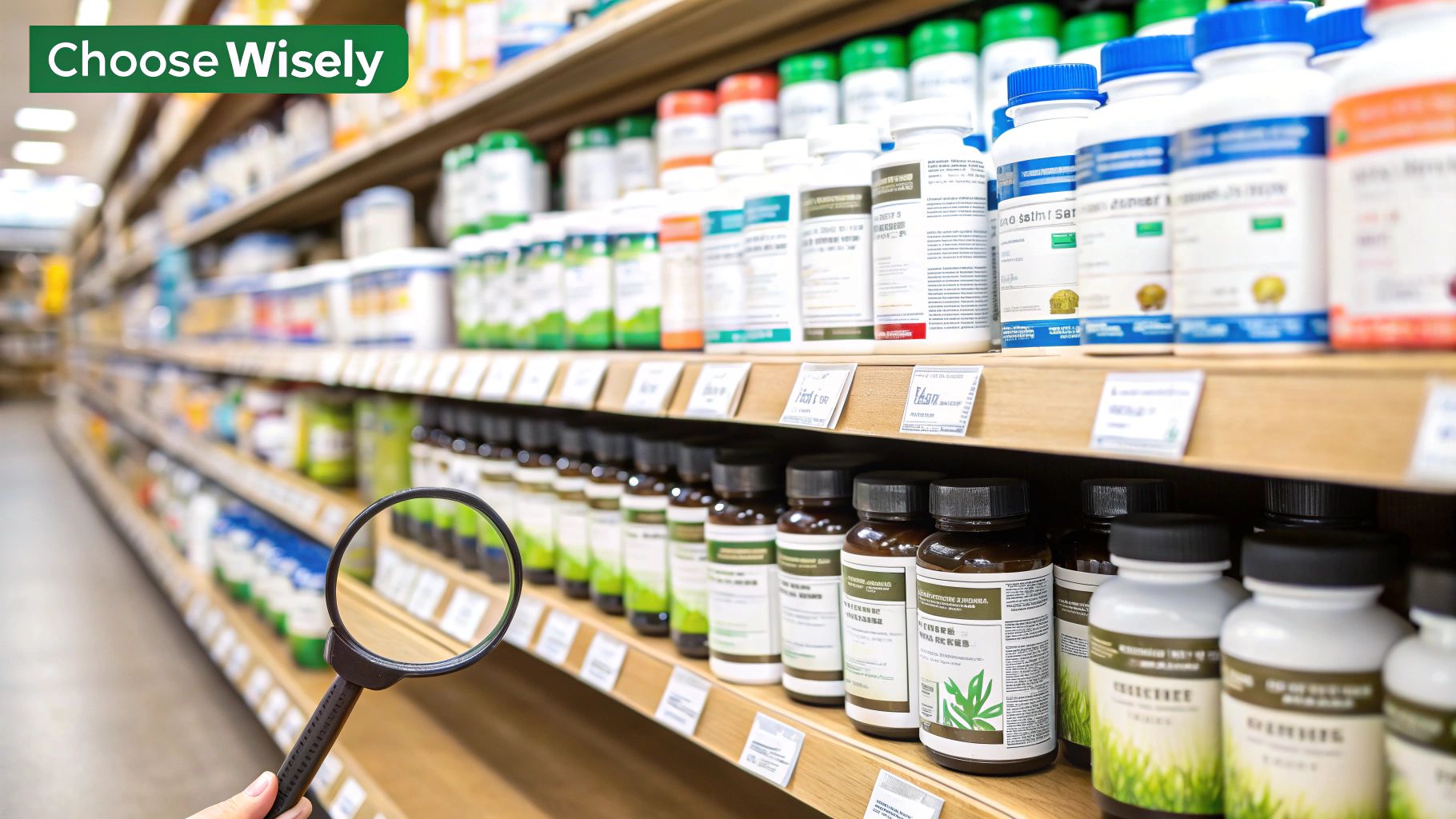Probiotics for Gut Health: Boost Digestion Naturally
Understanding Your Gut Microbiome Like a Pro
To get a real handle on how probiotics for gut health work their magic, it’s useful to understand the world they’re entering. Picture your gut not as a simple tube for digestion, but as a sprawling, lively city teeming with trillions of microscopic inhabitants. This inner metropolis is your gut microbiome, a complex community of bacteria, fungi, and other microbes that call your large intestine home. This community isn't just along for the ride; it's an active, crucial organ that affects nearly everything about your well-being, from digesting your kai to your mood in the morning.
Think of the helpful bacteria as the city’s essential workers: the engineers, waste management crews, and security guards. They’re on the job 24/7, breaking down parts of food your body can't manage on its own, manufacturing vital nutrients like B vitamins and vitamin K, and helping your immune system to tell friend from foe. A healthy gut microbiome is like a well-oiled city—everything runs smoothly, communication lines are clear, and the defences are solid. Studies show just how important this balance is, with the gut influencing up to 70% of your immune system.
The Inner Ecosystem: Harmony or Chaos?
When your gut microbiome is in balance, a state known as eubiosis, the good bacteria thrive and keep potentially disruptive microbes in line. This harmony keeps your inner "city" running efficiently. However, this balance is fragile. A number of factors can throw this internal peace off-kilter, leading to a state of imbalance called dysbiosis.
What causes this disruption? Think of it as a series of unexpected problems hitting our city:
-
Poor Diet: A diet heavy in processed foods and sugar is like feeding the city’s troublemakers while starving its essential workers. This encourages unhelpful bacteria to multiply.
-
Stress: Chronic stress is like a constant state of emergency, pulling resources away and weakening the city's infrastructure—your gut lining.
-
Antibiotics: While vital for fighting off infections, antibiotics act like an indiscriminate clean-up crew. They can wipe out both the troublemakers and the essential workers, leaving the city vulnerable.
-
Lack of Sleep: Not getting enough rest messes with the city's maintenance schedule, leading to poor repairs and a general decline in function.
Numerous studies shows the complex interactions within the gut microbiota, highlighting how diet and other factors influence its composition.
It is clear that a diverse population of beneficial bacteria is the key to a strong gut ecosystem, one that can bounce back from these daily pressures. This is exactly where specific strategies, like using probiotics, can make a difference. They serve as reinforcements, helping to bring skilled workers back into the city and restore order. For a closer look at how your lifestyle impacts this balance, you can find more information in our other articles about gut health. By grasping this core concept, you can see why adding beneficial microbes is a scientifically-backed way to support your body's natural systems.
How Probiotics Actually Work in Your Body

When you take probiotics for gut health, you're not just swallowing some bacteria; you're sending in a specialised team to restore order to your body's internal world. These living microorganisms have a specific job: to rebalance and strengthen your digestive system. Their mission starts the moment you consume them, but first, they must pass a major test: surviving the harsh, acidic conditions of your stomach. Well-formulated probiotics, particularly those in a live liquid form, are tough enough to make this trip and arrive in the intestines, ready to get to work.
Colonisation and Crowd Control
Once in the intestines, probiotics don't just drift by. Their main objective is to find a spot, settle in, and start to multiply. Picture them as expert gardeners entering a garden overrun with weeds. The first step is to clear out the unwanted growth to make room for healthy plants to flourish. Probiotics do this through a clever process called competitive exclusion.
This means they directly compete with less helpful, or pathogenic, bacteria for two vital resources:
-
Space: They latch onto the intestinal wall, occupying prime "real estate" and leaving no room for harmful microbes to take hold.
-
Nutrients: They consume the very food sources that nuisance bacteria need to thrive, essentially cutting off their fuel supply.
By taking up space and using available resources, probiotics effectively crowd out the troublemakers. This helps to shift the microbial balance in your gut towards a healthier, more organised community and can reduce common issues like bloating and gas, which are often the by-products of unwanted bacterial activity.
Rebuilding and Communicating for Better Health
Beyond just occupying territory, these beneficial microbes are busy workers that actively rebuild and improve their new environment. Their efforts create positive ripple effects that can be felt throughout your entire body.
One of their most critical jobs is to reinforce the gut barrier. Think of your gut lining as a tightly controlled border that prevents unwanted particles from leaking into your bloodstream. Probiotics help to patch up any weaknesses in this border, a condition sometimes called ‘leaky gut’. They signal the cells in your intestinal wall to produce more of the protective mucus that lines the gut.
Probiotics also act like tiny biological factories. As they break down the fibre from your food, they produce beneficial substances known as short-chain fatty acids (SCFAs). One of these, butyrate, is the main energy source for the cells of your colon. SCFAs also play a key part in lowering inflammation and communicating with your immune system. In fact, a thriving probiotic population helps "educate" your immune cells, teaching them to respond correctly to real dangers while not overreacting to harmless ones. This smart communication is a core reason why a healthy gut is so essential for overall wellness.
Meet Your Gut's Specialist Team: 12 Essential Probiotic Strains
Not all beneficial bacteria are made equal. Think of the probiotics world as teams of highly skilled specialists. You wouldn't ask a heart surgeon to fix a broken arm, and similarly, you need the right probiotic strain for the right job in your gut. Choosing the best probiotics for gut health means figuring out which "specialists" your internal ecosystem needs most. Each strain has a unique skillset, and they often perform best when grouped into carefully chosen teams.
This simple diagram shows the main roles of some of the most common probiotic families.

The image illustrates how different groups like Lactobacillus and Bifidobacterium are organised to handle distinct jobs, from supporting digestion to strengthening immunity.
The All-Stars of Your Gut Microbiome
Certain probiotics strains have been studied more than others for their powerful effects on digestive wellness. When you get to know these key players, you can read supplement labels like a pro and pick a product that genuinely matches your health aims.
To help you get started, we've put together a table comparing some of the most important probiotics strains and their roles. This will give you a clearer idea of which "specialists" might be right for you.
|
Strain Name |
Primary Benefits |
Best For |
Typical Dosage |
|---|---|---|---|
|
Lactobacillus acidophilus |
Maintains overall gut balance, produces lactic acid to inhibit harmful bacteria. |
General digestive health, post-antibiotic recovery. |
1-15 billion CFUs/day |
|
Bifidobacterium longum |
Soothes gut lining, calms immune system response, reduces inflammation. |
Supporting immunity, managing inflammatory gut issues. |
1-10 billion CFUs/day |
|
Saccharomyces cerevisiae |
Manages digestive issues like bloating and diarrhoea (especially antibiotic-associated). |
Post-antibiotic care, addressing acute digestive upset. |
250-1000 mg/day |
|
Bifidobacterium bifidum |
Supports immune function, helps break down complex carbohydrates. |
Enhancing nutrient absorption, immune support. |
1-5 billion CFUs/day |
|
Lactobacillus casei |
Aids in digestion, helps control diarrhoea, supports immunity. |
Diarrhoea management, general immune function. |
1-20 billion CFUs/day |
|
Lactobacillus rhamnosus |
Strong adherence to gut lining, supports gut barrier, prevents traveller's diarrhoea. |
Gut barrier integrity, travel health. |
1-20 billion CFUs/day |
Table: Key Probiotics Strains and Their Specialised Benefits
Comparison of major probiotic strains, their specific health benefits, and optimal usage scenarios.
This table shows that while some strains are great all-rounders, others are highly specialised. For example, L. acidophilus is a foundational strain for daily maintenance, while S. cerevisiae is a go-to for more acute problems.
The Power of a Multi-Strain Team
While a single strain can be useful, research increasingly shows that a multi-strain formula often delivers more well-rounded benefits. When different strains collaborate, their individual strengths are amplified in a process called synergy. Like your own personal internal construction crew: one strain might act as the demolition team, clearing out harmful bacteria, which then allows another strain, the builder, to attach to the gut wall and start repairing it.
A well-designed probiotic brings together multiple specialists into one effective force. This is why products like a daily balance probiotic are created with a blend of different strains. Such combinations ensure your gut gets a wide array of support, from improving how you absorb nutrients to fortifying your immune defences. Instead of hiring just one specialist, you’re bringing in an entire restoration team to look after every aspect of your gut's wellbeing.
The Real Science Behind Digestive Wellness Benefits

Beyond the marketing hype, a strong body of research shows how the right probiotics for gut health can truly support your digestive system. This isn't about miracle cures; it's about giving your body the biological resources it needs to work as it should. By introducing specific, helpful bacterial strains, you can begin to address common concerns like irritable bowel syndrome (IBS), disruptions caused by antibiotics, and even inflammatory responses.
Strengthening Your Gut's Defences
One of the most significant benefits of probiotics is their power to reinforce the gut barrier. Picture your gut lining as a tightly woven security gate that lets nutrients pass through while blocking harmful substances. When this gate gets damaged—a condition often called ‘leaky gut’—unwanted particles and toxins can slip into your bloodstream, sparking inflammation and triggering your immune system.
Probiotics act like a dedicated repair crew. They signal the cells in your gut wall to tighten their connections and produce more protective mucus. This effectively mends the gate, strengthening your body's first and most important line of defence against intruders.
A secure gut barrier also means better nutrient absorption. When your gut isn't constantly fighting off threats, it can properly focus on its primary job: breaking down your food and soaking up all the essential vitamins and minerals. This allows you to get more nutritional value from what you eat, leading to improved energy and vitality. This growing public understanding is a key reason the global probiotics market is set to grow at a rate of 11.2% each year between 2025 and 2029. To learn more about this trend, you can explore the complete probiotics market analysis.
The Gut-Brain Connection: A Two-Way Street
The influence of your gut microbiome doesn't stop at digestion; it travels all the way to your brain. This intricate communication network is known as the gut-brain axis. Your gut contains millions of nerve cells and is responsible for producing over 90% of your body's serotonin, a crucial chemical that helps regulate your mood.
When your community of gut bacteria is out of balance (a state called dysbiosis), the messages sent to your brain can get scrambled. This can contribute to feelings of anxiety, low mood, and brain fog. Probiotics help bring things back into harmony by:
-
Reducing inflammation: A calm gut sends calming signals to the brain.
-
Producing helpful compounds: Good bacteria create neurotransmitters and other molecules that have a positive effect on brain function.
-
Improving stress resilience: A balanced microbiome helps manage the production of the stress hormone cortisol.
By cultivating a healthy gut environment, probiotics don't just promote digestive comfort—they also support mental clarity and emotional wellbeing. This demonstrates the powerful connection between a happy gut and a happy mind.
Smart Shopping: Choosing Probiotics That Actually Work

Walking down the supplement aisle can feel overwhelming, with countless products all promising better gut health. But not all probiotics are created equal. To make a smart choice, you need to know how to spot a high-quality product that will actually deliver results. This means looking past flashy marketing and focusing on the crucial details on the label.
The growing consumer interest in natural wellness has made the probiotics market a significant part of New Zealand’s health industry. This niche sits within the larger vitamins and minerals sector, which is forecast to generate approximately $138.79 million in revenue by 2025. With so many options available, becoming an informed shopper is essential to ensure your investment pays off. You can discover more about New Zealand's growing interest in wellness products and see how this trend compares globally.
Decoding the Probiotic Label
Think of the label as a product's CV. It tells you everything you need to know about its potential effectiveness. A truly beneficial supplement will be transparent about its contents, potency, and formulation.
To help you distinguish between a premium product and an ineffective one, we’ve created a handy guide to the most important quality factors. The table below breaks down what to look for, why it's important, and which red flags to watch out for.
|
Quality Factor |
What to Look For |
Why It Matters |
Red Flags to Avoid |
|---|---|---|---|
|
Potency (CFUs) |
A guarantee of Colony Forming Units (CFUs) at the date of expiry, not just at manufacture. |
CFUs measure live, active bacteria. Numbers naturally decline, so an expiry guarantee ensures you get what you pay for. |
Vague "CFU at time of manufacture" claims; very low numbers (under 1 billion). (Although, fermented liquid variants can be more effective at lower counts) |
|
Strain Diversity |
A multi-strain formula with specific, well-researched strains listed by name (e.g., L. acidophilus). |
Different strains perform different jobs in the gut. A diverse team offers more comprehensive support. |
Generic terms like "probiotic blend" without listing the exact strains included. |
|
Delivery Format |
A format that protects bacteria from stomach acid, such as live liquid cultures or special enteric-coated capsules. |
Probiotics must survive the stomach's harsh environment to reach your intestines alive and ready to work. |
Standard gelatine capsules that dissolve too early, neutralising the beneficial bacteria. |
|
Third-Party Testing |
A mention of independent, third-party testing for purity and potency. |
This provides unbiased verification that the product contains what the label claims and is free from contaminants. |
No mention of quality control or third-party verification on the label or the company's website. |
|
Probiotic Quality Indicators: What to Look For |
|
|
|
|
Essential criteria for evaluating probiotic supplements including potency, packaging, and certification standards |
|
|
|
By keeping these points in mind, you can confidently assess whether a probiotic is likely to be effective or just clever marketing.
Capsules vs. Liquids: Which is Better?
The form your probiotic takes is a crucial factor in its effectiveness. For years, freeze-dried powders sealed in capsules were the standard. However, these bacteria are dormant and need to be "woken up" or rehydrated to become active, a process that can reduce their viability before they even get to work.
A high-quality live liquid probiotic offers a distinct advantage. The bacteria are already alive, active, and fermented in a nutrient-rich medium. This means they are primed to start their job the moment they reach your gut, with no activation delay. Many people find that this format leads to faster and more noticeable results.
When considering your options, it's helpful to understand the full range of gut health supplements available to find what best fits your lifestyle and digestive needs. Choosing wisely ensures your efforts to support your gut health journey are as effective as possible.
Maximizing Results: Timing, Diet, and Lifestyle Integration
Taking a high-quality probiotic is an excellent move for your health, but to really see the benefits, you need to create an environment where these good bacteria can thrive. Think of it like planting a beautiful garden. You wouldn't just scatter expensive seeds on hard ground and walk away. You’d prepare the soil, water them, and make sure they get sunlight. In the same way, optimising your diet, timing, and daily habits provides the perfect "soil" for your new microbial allies to flourish.
Perfecting Your Probiotic Timing
When you take your probiotic can make a real difference. The aim is to get the highest number of live bacteria safely through the acidic environment of your stomach and into your intestines. If you're using tablet or freeze-dried probiotics then timing becomes a more critical factor. While there are different schools of thought, a good rule of thumb is to take probiotics on an empty stomach, about 20-30 minutes before a meal, or with a light meal. This can help buffer the stomach acid just enough without slowing down digestion, giving the probiotics a clearer path to where they need to go.
However, if you're using a liquid probiotic like Rawbiotics, the bacteria are already active and resilient. The more crucial factor, however, is consistency. Taking your probiotic at the same time every day helps maintain a steady supply of beneficial microbes, allowing them to establish a strong presence and maintain balance in your gut.
Fuelling the Good Guys: The Role of Prebiotics
Once your probiotics have reached their new home in your gut, they need food to survive and multiply. This is where prebiotics play a vital role. Prebiotics are specific types of dietary fibre that your body can't digest, but they are the preferred food source for your friendly gut bacteria. While you can supplement prebiotics it can be easier and more cost effective to add prebiotic-rich foods to your diet is like serving a gourmet feast for your internal ecosystem.
Foods that are fantastic sources of prebiotics include:
-
Garlic and onions
-
Bananas (especially when a little green)
-
Asparagus
-
Oats and barley
-
Apples
-
Chicory root
On the flip side, a diet high in sugar and processed foods can work against you by feeding the less desirable bacteria, which then compete with your probiotics. Simple changes, like choosing whole-grain bread over white or grabbing an apple instead of a biscuit, can make a substantial difference.
Lifestyle Factors That Shape Your Microbiome
Your daily habits have a huge effect on your inner world. Even the best probiotics will have a tough time in a body that’s constantly stressed or sleep-deprived. Chronic stress can alter your gut environment, making it a less welcoming place for friendly bacteria. Similarly, not getting enough sleep has been shown to reduce the diversity of your microbiome.
Building a gut-friendly lifestyle is a key piece of the puzzle. Simple strategies can help create the right conditions for your probiotics to do their best work:
-
Manage Stress: Try incorporating practices like deep breathing, meditation, or a peaceful walk in nature.
-
Prioritise Sleep: Aim for 7-8 hours of quality sleep each night to give your gut time to rest and repair.
-
Move Your Body: Regular, moderate exercise helps get your digestion moving and has been shown to positively influence gut bacteria.
By pairing great probiotics with smart timing, a prebiotic-rich diet, and a healthy lifestyle, you're doing more than just taking a supplement—you're actively cultivating a resilient and vibrant internal garden.
Your Personalised Gut Health Action Plan
Turning what you've learned into practical steps is the most crucial part of your journey. Using probiotics for gut health is far more effective when it's a deliberate strategy, not just something you do now and then. This plan will help you create a straightforward, step-by-step roadmap that fits your body’s unique needs and daily life. The aim is to build a sustainable routine that brings real, lasting results.
Getting Started: A Gentle Introduction
When you first bring a probiotic into your routine, it’s wise to start slowly. This approach gives your existing gut microbiome time to welcome the new arrivals, which helps minimise potential side effects like temporary gas or bloating as your internal community adjusts.
-
Start with a half dose: For the first week, try taking half the recommended amount. If you're using a liquid probiotic, then dosage management is a whole lot easier, this would be about 15ml instead of the full 30ml.
-
Observe your body: Pay close attention to how you feel. Any initial adjustment period is usually short, often lasting only a few days.
-
Gradually increase: After a week, if you're feeling good, you can move up to the full recommended daily dose. This careful start helps ensure a smooth transition.
Tracking Your Progress and Making Adjustments
So, how can you tell if it’s working? The signs are often subtle at first but become clearer over time. Keeping a simple journal can be a great way to connect the dots between your new habit and improvements in your overall wellbeing.
What to Monitor:
-
Digestive Symptoms: Make a note of any changes in bloating, how regular your bowel movements are, and your general stomach comfort. Are you feeling less discomfort after eating?
-
Energy Levels: A balanced gut helps your body absorb nutrients more effectively, which can lead to a noticeable, steady rise in your daily energy.
-
Immune Resilience: Have you noticed you’re getting sick less often? Catching fewer common colds and bugs is a key sign of a well-supported immune system.
If you haven't seen positive changes after 4-6 weeks, it might be time to take a closer look. Think about other factors like your diet, stress levels, and sleep quality. Could other lifestyle habits be working against the benefits of your probiotic? Small tweaks, like eating more prebiotic-rich foods such as garlic, onions, and bananas, can give your probiotics the fuel they need to thrive.
Overcoming common hurdles often boils down to consistency. Make sure you take your probiotic every day to maintain a stable, beneficial microbial community. Ultimately, listening to your body is your best guide; it will let you know when you’re on the right path.
Ready to put your plan into action with a premium, live liquid probiotic? Explore the Rawbiotics range and find the perfect formula to support your personalised gut health journey.